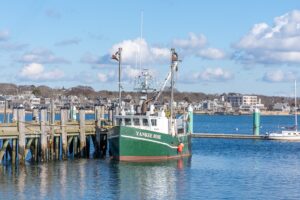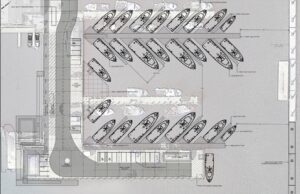PROVINCETOWN — Every year, about a quarter-million passengers arrive or depart from the ferry terminal at the tip of Provincetown’s MacMillan Pier. Meanwhile, a fleet of commercial fishing vessels unload around four million pounds of seafood. Another 70,000 people board whale-watch trips to see humpback, fin, and minke whales feed in Cape Cod’s nutrient-rich waters — and that’s just one of several types of excursions that leave from the pier’s west side.

This center of activity was substantially rebuilt in the early 2000s, but parts of it are much older, including the two “finger piers” that serve the town’s scallop and sea clam boats. At its Jan. 13 meeting, the select board endorsed a $12-million plan to renovate the pier and authorized the Dept. of Public Works to pursue advanced designs and permits for the project.
The renovation is expected to take six years, with work broken into several steps, partly to maximize its eligibility for the state’s Seaport Economic Council grants, which can total $1 million per year. The first step would be to extend the town’s new wave attenuator, which was built east of the pier in 2019, to further protect the pier’s tip from nor’easters.
Both finger piers would be replaced by floating concrete docks similar to the ones in use by the town’s fleet of 41 lobster boats. The two floating docks and new unloading areas would be able to accommodate 27 large fishing boats at a time — essentially doubling the current 14-vessel capacity of that part of the pier, according to Pier Manager Jamie Demetriou.
“We’re at capacity right now,” said Demetriou, “and I’m constantly being asked, ‘What can I do to get a slip?’ We lose two to three boats a year as people retire, but I fill those slips immediately.”
The new floating docks are designed for commercial fishing boats from 40 to 80 feet long. The trend in commercial fishing lately has been toward bigger boats, Demetriou said, with even lobster fishermen moving to larger vessels.
The current vessel size limit on the finger piers is around 56 feet, Demetriou said, while the floating docks that serve the lobster fleet can hold boats up to 46 feet long.
“More than $9 million worth of seafood was landed here last year,” said Demetriou, citing the price paid by wholesale dealers for town fishermen’s catch.

In the project’s middle phases, the floating ferry dock and gangway would be replaced with a 1,925-square-foot ferry terminal built on concrete floats and anchored to a second smaller wave attenuator that would wrap around the southwest corner of the pier.
The dual wave attenuators will protect the new floating structures, consultant Mack Bryan of Foth Infrastructure and Environment told the select board, and locating the ferry terminal on a floating platform will also help relocate the line of passengers that causes congestion at the pier during the busy season. The new ferry terminal will include bathrooms, ticket counters, and a comfortable waiting area that is sheltered from the wind.
Currently, the tip of the pier holds nothing but a large open-air gazebo, which will be torn down. A new harbormaster building will take its place in the project’s fourth phase, set for 2029.
By the project’s end, there will be new unloading cranes, a larger offloading area, and a catch-storage facility added to the east side of the pier. After the harbormaster building and public bathrooms are removed from their current location on the pier’s east side, that section will be restriped to add more parking spaces.
Hoping for Grants
Including the permitting and design work — which is expected to take all of 2025 and 2026 — the project’s six phases are expected to cost $2 million to $2.5 million each, for a total of $12.2 million.

The grant environment is uncertain right now, DPW Director Jim Vincent told the select board, but the town hopes to find significant outside support for the project.
“One of the big pushes that Jim had in the beginning was the desire to obtain grants for some of these components through a phased program,” consultant Scott Skuncik told the board. He cited federal Dept. of Transportation grants for ferry infrastructure, Dept. of Agriculture grants for commercial fisheries, and state Coastal Zone Management grants for protecting vulnerable coastal structures.
Grant funding rules are also a major reason so many of the project’s elements are floating rather than fixed, Vincent said.
“There’s a lot of changes in the wind about not putting buildings out on piers,” said Vincent. “We’re expecting it to be more difficult to put any type of structure on piers in the future.”
The state’s Seaport Economic Council had already funded the feasibility study being presented that day, Skuncik told the select board, “and I would expect their support to continue as long as progress is being shown.”
That feasibility study began with a detailed analysis of existing conditions at the pier, including a visual inspection of its underside and underwater components. The inspection report, dated August 2023, runs to 267 pages.
“For the last 20 years, the Pier Corp. was putting in their own pilings and making up their own mind about what needed to be done,” said MacMillan Pier Commission chair Jamie Staniscia, who served on the Pier Corp. board from 2020 until it was abolished by town meeting voters in 2024. Staniscia was the only member of the Pier Corp. board to be appointed by the select board to the new advisory pier commission that spring.
The select board unanimously endorsed the plan.
This comprehensive approach to the pier’s maintenance “is long overdue,” Staniscia told the Independent. He added that he thought it had resulted in “a responsible plan for the town.”



